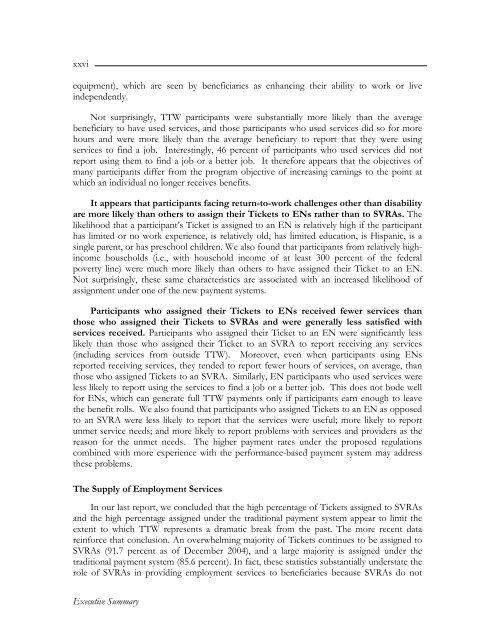Evaluation of the Ticket To Work Program - Mathematica Policy ...
Evaluation of the Ticket To Work Program - Mathematica Policy ...
Evaluation of the Ticket To Work Program - Mathematica Policy ...
You also want an ePaper? Increase the reach of your titles
YUMPU automatically turns print PDFs into web optimized ePapers that Google loves.
xxvi<br />
equipment), which are seen by beneficiaries as enhancing <strong>the</strong>ir ability to work or live<br />
independently.<br />
Not surprisingly, TTW participants were substantially more likely than <strong>the</strong> average<br />
beneficiary to have used services, and those participants who used services did so for more<br />
hours and were more likely than <strong>the</strong> average beneficiary to report that <strong>the</strong>y were using<br />
services to find a job. Interestingly, 46 percent <strong>of</strong> participants who used services did not<br />
report using <strong>the</strong>m to find a job or a better job. It <strong>the</strong>refore appears that <strong>the</strong> objectives <strong>of</strong><br />
many participants differ from <strong>the</strong> program objective <strong>of</strong> increasing earnings to <strong>the</strong> point at<br />
which an individual no longer receives benefits.<br />
It appears that participants facing return-to-work challenges o<strong>the</strong>r than disability<br />
are more likely than o<strong>the</strong>rs to assign <strong>the</strong>ir <strong>Ticket</strong>s to ENs ra<strong>the</strong>r than to SVRAs. The<br />
likelihood that a participant’s <strong>Ticket</strong> is assigned to an EN is relatively high if <strong>the</strong> participant<br />
has limited or no work experience, is relatively old, has limited education, is Hispanic, is a<br />
single parent, or has preschool children. We also found that participants from relatively highincome<br />
households (i.e., with household income <strong>of</strong> at least 300 percent <strong>of</strong> <strong>the</strong> federal<br />
poverty line) were much more likely than o<strong>the</strong>rs to have assigned <strong>the</strong>ir <strong>Ticket</strong> to an EN.<br />
Not surprisingly, <strong>the</strong>se same characteristics are associated with an increased likelihood <strong>of</strong><br />
assignment under one <strong>of</strong> <strong>the</strong> new payment systems.<br />
Participants who assigned <strong>the</strong>ir <strong>Ticket</strong>s to ENs received fewer services than<br />
those who assigned <strong>the</strong>ir <strong>Ticket</strong>s to SVRAs and were generally less satisfied with<br />
services received. Participants who assigned <strong>the</strong>ir <strong>Ticket</strong> to an EN were significantly less<br />
likely than those who assigned <strong>the</strong>ir <strong>Ticket</strong> to an SVRA to report receiving any services<br />
(including services from outside TTW). Moreover, even when participants using ENs<br />
reported receiving services, <strong>the</strong>y tended to report fewer hours <strong>of</strong> services, on average, than<br />
those who assigned <strong>Ticket</strong>s to an SVRA. Similarly, EN participants who used services were<br />
less likely to report using <strong>the</strong> services to find a job or a better job. This does not bode well<br />
for ENs, which can generate full TTW payments only if participants earn enough to leave<br />
<strong>the</strong> benefit rolls. We also found that participants who assigned <strong>Ticket</strong>s to an EN as opposed<br />
to an SVRA were less likely to report that <strong>the</strong> services were useful; more likely to report<br />
unmet service needs; and more likely to report problems with services and providers as <strong>the</strong><br />
reason for <strong>the</strong> unmet needs. The higher payment rates under <strong>the</strong> proposed regulations<br />
combined with more experience with <strong>the</strong> performance-based payment system may address<br />
<strong>the</strong>se problems.<br />
The Supply <strong>of</strong> Employment Services<br />
In our last report, we concluded that <strong>the</strong> high percentage <strong>of</strong> <strong>Ticket</strong>s assigned to SVRAs<br />
and <strong>the</strong> high percentage assigned under <strong>the</strong> traditional payment system appear to limit <strong>the</strong><br />
extent to which TTW represents a dramatic break from <strong>the</strong> past. The more recent data<br />
reinforce that conclusion. An overwhelming majority <strong>of</strong> <strong>Ticket</strong>s continues to be assigned to<br />
SVRAs (91.7 percent as <strong>of</strong> December 2004), and a large majority is assigned under <strong>the</strong><br />
traditional payment system (85.6 percent). In fact, <strong>the</strong>se statistics substantially understate <strong>the</strong><br />
role <strong>of</strong> SVRAs in providing employment services to beneficiaries because SVRAs do not<br />
Executive Summary
















